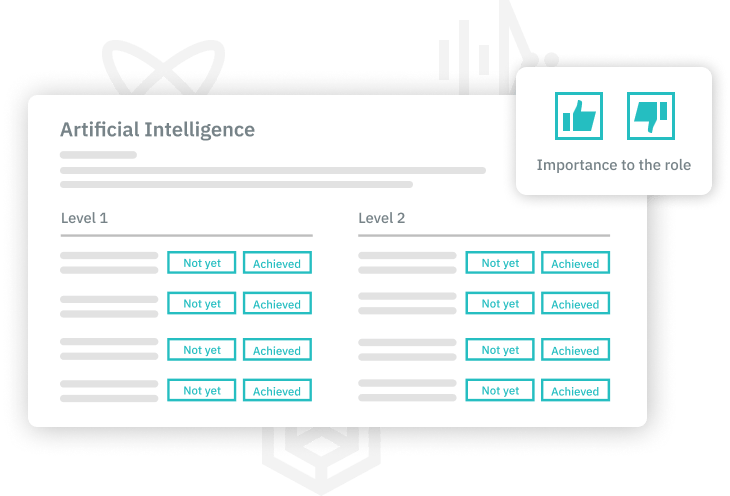Importance of a Standardized Taxonomy

The importance of a standardized taxonomy is crucial in shaping effective talent management within an organization. This structured framework offers a consistent way to define and categorize job roles, skills, and competencies across departments, providing a common language and aligning employees and leadership with clear expectations. When implemented effectively, a standardized taxonomy enhances talent development, recruitment, onboarding, performance management, and workforce planning, ultimately supporting organizational growth and scalability.
The Role of Consistency and Clarity in Talent Management
One of the foundational advantages of a standardized taxonomy is the consistency it brings to talent management. In many organizations, job roles and skill requirements are defined differently across teams and departments, leading to inconsistencies that can create confusion and limit the effectiveness of HR initiatives. By establishing a uniform language for describing roles, skills, and competencies, a standardized taxonomy ensures that everyone within the organization understands the expectations and requirements associated with each position. This consistency makes communication clearer and improves alignment between employees and managers, as well as among cross-functional teams.
Clear benchmarks for skills and competencies further reinforce this consistency. When the same standards are applied across departments, it becomes easier to evaluate employee performance and potential, regardless of their specific roles or geographic location. Organizations can use these benchmarks to create a level playing field where talent evaluations are fair and objective, reducing any biases that may otherwise arise from subjective or inconsistent criteria.
Enhancing Talent Development with Targeted Approaches
A well-defined taxonomy supports talent development by clarifying the exact skills and competencies required for each role. This clarity enables HR teams to design targeted training programs that address employees’ specific developmental needs. For instance, rather than offering generic training, HR can pinpoint and cultivate the precise skills that employees need to succeed in their roles and advance within the organization. This targeted approach not only makes training programs more effective but also boosts employee engagement by showing a commitment to their professional growth.
Moreover, with a standardized taxonomy, organizations can create structured career progression paths. Employees can see the specific competencies and behaviors needed to move up within their job family or transition into a new role. For example, an entry-level employee in marketing can clearly understand the skills they need to develop to advance to a senior marketing analyst or team lead role. This transparency around career progression is a powerful motivator, as employees feel empowered to take control of their career development when they know what steps to take to achieve their goals. By offering a clear roadmap, organizations can foster a culture of continuous learning and development that benefits both employees and the company as a whole.
Recruitment and Onboarding: Setting the Foundation for Success
The impact of a standardized taxonomy begins even before employees join the organization. Accurate job descriptions play a significant role in attracting the right candidates. When job profiles are based on standardized competencies, recruitment teams can create job postings that are both specific and aligned with organizational needs. This accuracy in role descriptions helps attract candidates who possess the skills and attributes required for success, reducing the chances of mismatches and lowering turnover rates over time.
In onboarding, a standardized taxonomy accelerates the process by giving new hires a clear understanding of their responsibilities and performance expectations from day one. Rather than struggling to understand their role through vague or inconsistent information, new employees can reference a well-defined framework that outlines what is expected of them. This clarity not only helps new hires acclimate to their roles more quickly but also fosters a sense of belonging, as they can immediately see how their position fits within the larger organizational structure. An effective onboarding process is crucial for employee engagement and retention, and a standardized taxonomy provides the foundation needed for a smooth transition into the organization.
Improving Performance Management with Objectivity and Fairness
Performance management often suffers from subjectivity, with managers evaluating employees based on personal judgments rather than objective criteria. A standardized taxonomy helps eliminate this subjectivity by providing a clear, consistent framework for performance evaluations. With competencies and proficiency levels defined across the organization, managers can assess employees based on standardized criteria, ensuring that evaluations are both fair and aligned with organizational expectations.
This objective approach benefits employees by providing them with constructive, actionable feedback. When employees understand how their performance is measured and how they can improve, they are more likely to engage in their development actively. For example, if an employee knows they need to improve their project management skills to reach the next level, they can focus their efforts on developing that competency. This transparency makes performance management a more positive experience, turning evaluations into opportunities for growth rather than just assessments of past performance.
Strategic Workforce Planning: Building a Future-Ready Organization
Strategic workforce planning is critical for any organization looking to remain competitive in a rapidly changing business environment. A standardized taxonomy enables effective workforce planning by helping HR teams identify skill gaps within the organization. By comparing employees’ current competencies to the standardized benchmarks, HR can pinpoint areas that need development and proactively address these gaps through targeted training or hiring initiatives. For example, if an organization is planning to expand its data analytics capabilities, HR can assess the current skills within this field and identify areas where further development is required.
In addition to gap analysis, a standardized taxonomy supports succession planning by providing clear definitions of the roles and skills necessary for leadership positions. By identifying high-potential employees and understanding the competencies they need to develop, organizations can prepare these individuals for future leadership roles. Succession planning becomes a structured, data-driven process rather than a reactive measure, enabling the organization to build a strong leadership pipeline that is prepared to meet future challenges.
Facilitating Integration and Scalability
As organizations grow, so does the complexity of their talent management processes. A standardized taxonomy provides the scalability needed to accommodate this growth, allowing for consistent talent management practices even as the organization expands. For example, new roles and skills can be easily added to the taxonomy, maintaining consistency and avoiding the need to start from scratch with each new addition.
Moreover, a standardized taxonomy streamlines the integration of various HR systems, including learning management systems, performance management tools, and HR information systems. When each of these systems shares a common framework for roles and competencies, data can flow seamlessly across platforms, reducing administrative burdens and enhancing data accuracy. This integration is essential for creating a unified HR ecosystem where information is easily accessible, reducing redundancies and improving overall efficiency.
The Broader Impact of a Standardized Taxonomy on Organizational Success
The benefits of a standardized taxonomy extend beyond HR processes; they contribute to an organization’s overall success by ensuring consistency, clarity, and fairness across talent management practices. With a common language and clear benchmarks, employees and managers alike can make better-informed decisions, enhancing engagement and productivity. Employees feel more connected to their roles and their career progression, knowing that they are evaluated fairly and that their development is actively supported.
For leadership, the clarity provided by a standardized taxonomy means that they can make strategic decisions regarding talent with confidence. Workforce planning, succession planning, and performance evaluations all become more streamlined and accurate, enabling the organization to respond more effectively to market changes and internal needs. This adaptability is a significant advantage in a competitive business environment, where the ability to adjust quickly can make the difference between success and stagnation.
A standardized taxonomy also fosters a culture of continuous learning. With clear expectations and defined progression paths, employees are encouraged to actively engage in their development, knowing that they have a visible path toward career growth. This culture not only supports individual employees but also strengthens the organization as a whole by creating a workforce that is both skilled and motivated.
In summary, a standardized taxonomy is more than just a tool for HR—it is a foundational element of effective talent management that drives organizational alignment, enhances employee engagement, and prepares the company for sustainable growth. By providing consistency and clarity, it allows organizations to manage talent strategically, building a workforce that is ready to meet the demands of today’s dynamic business landscape. Organizations that implement a standardized taxonomy benefit from improved talent development, streamlined recruitment, fair and objective performance management, and a strategic approach to workforce planning that positions them for future success. In essence, a standardized taxonomy is not just a resource for managing talent—it is a catalyst for organizational growth and resilience.
See a preview of TalentGuard’s platform
Centralized Talent Development Software for Acquisitions
As companies expand through acquisitions, they often face the significant challenge of integrating varied organizational cultures, centralized talent development software, and processes. Nowhere is this more complex than in talent management, where HR Business Partners (HRBPs) are tasked with aligning talent data across multiple newly acquired entities. The acquisition process brings together diverse sets of […]
AI-Powered Job Role Creation and Maintenance
HR teams and Subject Matter Experts (SMEs) play a crucial role in crafting and maintaining technical roles within organizations. Yet, this process is often laborious and time-consuming, demanding meticulous attention to detail and a deep understanding of organizational needs. Enter TalentGuard’s WorkforceGPT Generative AI, a game-changer in simplifying the complexity of skills-based role creation and […]
The Business Case for Skills Matrix Software
Effectively managing and updating employee skills is a vital part of any organization’s success. In today’s rapidly evolving business landscape, having a system to accurately track, analyze, and develop workforce skills can make the difference between maintaining a competitive edge or falling behind. While Excel has traditionally been a go-to tool for various business applications, […]




